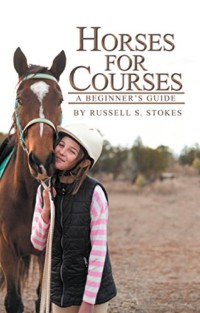Title: Horses for Courses: A Beginner’s Guide
Author: Russell S. Stokes
Publisher: XlibrisUS
ISBN: 978-1-5434-0927-7
Pages: 64
Genre: Animal Care & Pets
Reviewed by: Allison Walker
Pacific Book Review
There is a marked difference between being a horse rider and being a horseman. A rider knows how to work the horse and make the horse look good under saddle. But exiting the arena, a rider passes the horse off to a groom and mounts up on the next ride. A horseman is harder to find. A horseman knows how to ride, but he also knows how to medicate an ill horse, convince a balking horse to lead gently, brush a dull coat until it shines again, and when straw bedding is needed over sawdust.
Russell S. Stokes is a born horseman, the way all true horsemen must be born before they can be made. For every bit of love in his heart for horses, there is an equal amount of respect. The right measure of each of these is what makes Stokes a fine horseman; it’s his innate desire to learn and teach others that also make him a fine coach.
Horses for Courses is the first addition of Stokes’ lifetime of learning put into print. In his book, Stokes offers helpful tips and brief information on everything from pasture fencing to mounting up. In this case, knowing so much becomes a handicap when it becomes too much to organize. While the quality of the subject matter is indisputably expert, the book’s intended audience is indistinct. Horses for Courses is sometimes written for a novice; including fundamentals such as definitions for basic coat colors. Then the book suddenly gains experience, assuming a reader who does not know basic colors already has a thorough knowledge of tack. What you end up reading is a book which gives tips on buying your first horse, then 38 pages later teaches riders how to be instructors. Horses for Courses is a catchall for amateur and professional horsemen, and thus has a wide reading audience.
Stokes includes several high quality photos at the end of the book, which without captions feel more like a photo album than a beginner’s guide. These photos would make helpful illustrating points throughout, but have no captions to help the amateur horseman know what he’s looking at. For example, photos of Stokes’ riding pupils could pinpoint some common mistakes and visually describe how a rider should hold their hands and heels. Any reader able to follow along with Stokes’ written directions is well placed in the saddle, but the rest of us fumble to visualize the directions when any of Stokes’ photos would show riders immediately what to do.
Horses for Courses is an excellent resource for information. Stokes’ emphasis on safety for the rider as well as the horse, accompanied by his lifetime of experience, makes for an educational and accountable guide. Readers will gain much of the inherent respect for the equestrian, as well as the mysteries of the horse as they are revealed.


